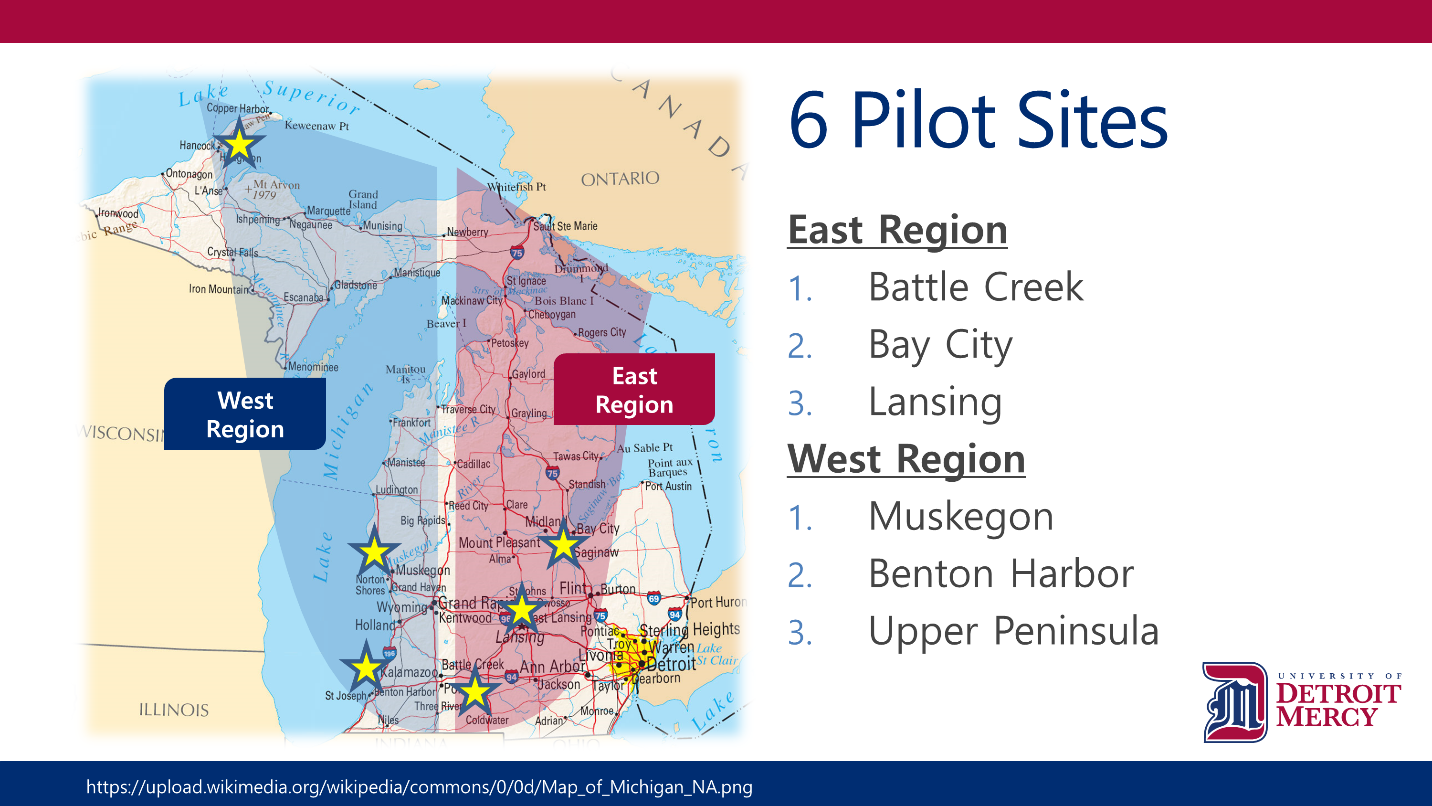Placing registered dental hygienists in OBGYN medical clinics to provide care for pregnant mothers, meeting patients where they are to improve access and outcomes.
Purpose of the Project
The purpose of the Michigan Initiative for Maternal and Infant Oral Health is to improve oral health of mothers and children in under-served areas. The grant-funded effort began as a 1-year project at 6 pilot sites. The initial aim was to examine the feasibility and impact of placing a registered dental hygienist within an OBGYN medical clinic. While the approach was an important first step toward reaching patients in the inaugural year, it was essential to strategically plan a more robust sustainable model while concurrently building the new program.
Quality Care
Hardworking well-educated healthcare clinicians who provide medical and dental services to families often experience difficulties in care delivery due to loosely organized inter-professional collaborations. Prioritizing the environment and processes at clinics can help ensure better quality care. Healthcare quality is generally measured by five characteristics: safe, timely, effective, efficient, equitable, patient-centered (STEEEP). While specific applications of these components vary, the Michigan Initiative for Maternal and Infant Oral Health addressed all five during implementation and strategic planning.
Implementation
The Grace Health Model for Pregnant Mothers began in November 2014 when dental hygienists started seeing patients in the OB/GYN department. This successful program established a template for five other Federally Qualified Health Center (FQHC) pilot sites to build from and mimic throughout Michigan.
Strategic Planning
Other pilot sites contributed input to (i) enhance and standardize current workflow; (ii) expand the scope of services rendered; and (iii) include pregnant mothers and their children up to age 3 years. The Muskegon Family Care Dental Coach Model supplemented the Grace Health Model and bridged the gap between the OBGYN and pediatric clinical teams. New processes help all family members establish a dental home.
Mission and Vision
The University of Detroit Mercy School of Dentistry, Michigan Department of Health and Human Services, and Michigan Primary Care Association will improve oral health outcomes for mothers and children through organization quality care.

Disclosure: The content in this section is adapted from the grant application submitted to the Michigan Department of Health and Human Services titled “At-Risk Mothers and Children Dental Program.”
During pregnancy, physical and physiological changes occur that can adversely affect the mouth. Gingivitis is the most common oral condition of pregnancy, effecting about 3 in 4 pregnant women.[1] Left untreated, gingivitis may progress to periodontal disease which may destroy both soft and hard tissues. Other oral conditions commonly occurring during pregnancy include benign oral gingival lesions, tooth mobility, tooth erosion and dental caries (cavities). Pregnant women are at high risk for dental caries due to a variety of reasons including inadequate amounts of fluoride, high intake of sugary food or beverages, and a lack of oral health care.
To effectively improve oral health among pregnant women and children, it is important to understand and address two contributing factors: health literacy and oral health disparities by race, ethnicity and income. Often, those with low levels of health literacy are found among these same vulnerable populations. Several national organizations have undertaken efforts to promote oral health among pregnant women and children. They developed statements, guidelines, educational materials, and tools to improve oral health. These include: the American Congress of Obstetricians and Gynecologists (ACOG), the American Academy of Pediatric Dentistry (AAPD),[2] the American Academy of Pediatrics (AAP),[3] the American Academy of Periodontology, the American Academy of Physician Assistants (AAPA), the American College of Nurse-Midwives (ACNM), the Society of Teachers in Family Medicine (STFM), and the American Dental Association (ADA).
In 2008, an expert panel convened by the U.S. Maternal and Child Health Bureau (MCHB) developed strategies for improving perinatal oral health. One strategy was to “promote the use of guidelines addressing oral health during the perinatal period and to disseminate guidelines to Maternal and Child Health and Oral Health professionals.” This led to the development of a national consensus statement in collaboration with ACOG and the ADA “Oral Health Care during Pregnancy: A National Consensus Statement,” as well as a Committee Opinion from ACOG “Oral Health Care During Pregnancy and Through the Life Span.” Several states including New York, California, South Carolina, and Washington developed statewide practice guidelines for perinatal oral health.
Health professionals often do not provide oral health care to pregnant women and pregnant women often do not seek or receive oral health care. Some pregnant women and health professionals do not understand that oral health care is an important component of a healthy pregnancy. Early childhood caries is a preventable infectious disease, and this project proposes to provide perinatal and prenatal preventative oral health care to high-risk populations. We will study the attitudes of high risk populations and their physician providers to educate them about the importance of an oral health program as a part of the comprehensive oral health plan.
Goals
- Pregnant women are provided dental services and referrals made to the dental providers for follow-up care
- Develop and/or locate materials to educate pregnant women who receive services and chair-side curriculum to educate pregnant women
- Collect demographic, caries risk, and dental disease data using EHR
- Collect saliva samples from participants
- Develop a brief, plain language client satisfaction survey or equivalent evaluation methodology
Measurements
- # of women who participate in the program, number of women who receive services and pre- and post-natal oral health education
- # of women who have received the educational material
- Data for all participants will be collected
- Database will be maintained
- Report will be completed on patient experiences and satisfaction
Sources
[1]Patton LL. The ADA Practical Guide to Patients with Medical Conditions. John Wiley & Sons; 2015.
[2]Guideline on Perinatal and Infant Oral Health Care. Pediatric Dentistry. 2016;38(6):150-154.
[3]American Academy of Pediatrics, American College of Obstetricians and Gynecologists Committee on Obstetric Practice. Guidelines for Perinatal Care. American Academy of Pediatrics; 2017.